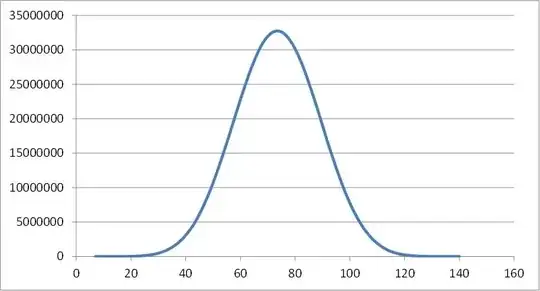Here's a simple way to use a spreadsheet (such as Excel or
OpenOffice Calc) to compute the probability of rolling any given sum
on any (not too large) number of $20$-sided dice.
On a blank spreadsheet, put a zero in cell A$22$, $1$ in cell B$22$, the formula =A22+1 in cell A$23$, and the formula =0.05*SUM(B3:B22)
in cell C$23$.
(Alternatively, put =SUM(B3:B22)/20 in cell C$23$, since multiplication
by $0.05$ has the same effect as division by $20$.)
\begin{array}{|c|c|c|c|c|c|c|c|c|}\hline
& A & B & C & D & E & F & G & H & I \\ \hline
1 & & & 1 & 2 & 3 & 4 & 5 & 6 & 7 \\ \hline
2 & \\
\vdots & \\
21 & \\ \hline
22 & 0 & 1 & \\ \hline
23 & \text{=A22+1} & & \text{=0.05*SUM(B3:B22)}& \\ \hline
24 & \\
\vdots & \\ \hline
\end{array}
Leave rows $2$ through $21$ and all the other cells of row $22$ blank.
(Alternatively, you can put zeros in any of those cells.
But do not put anything else there.)
Copy cell C$23$ to the row of cells D$23$:I$23$ for seven dice.
The idea is that the number of columns in which you have copies of cell C$23$
(including column C itself) should be equal to the number of dice you
want to roll.
Now copy row $23$ to rows $24$, $25$, $26$, and as many rows below that
as you will need so that the numbers in column A include all the sums you
could possibly roll on your dice.
(There will also be some sums there you can't roll--for example
you cannot roll $1$, $2$, or $6$ on seven dice. That's OK.)
The greatest sum you can roll on seven d$20$s is $140$, so for seven dice
you will want to make copies of row $23$ in all the rows from
row $24$ to row $162$.
The cells in the range C$23$:I$162$ (seven columns by $140$ rows)
will now be a table of the probabilities of rolling any sum on any number of
d$20$s up to seven d$20$s. For example, to see the probability to roll
a sum of $10$ on three dice, find the cell in the third column of the
tenth row of the range C$23$:I$162$; that is, look in cell E$32$.
(You should find the value $0.0035$ there.)
The numbers in column A are just there to help you find the desired
row of the probability table.
Optionally, you can put the numbers $1$, $2$, $3$, and so forth in row $1$,
starting in column C, as shown in the figure above,
to help you find the desired column.
(You can hide rows $2$ through $22$ to avoid having a large gap between
these column headers and the rest of the table.)
Then the numbers in row $1$ are the number of dice rolled and the
numbers in column A are the sums rolled.
So far this shows only the probabilities for rolling certain sums
exactly. To find the probability that $X\geq91$ (rolling $91$
or greater on seven d$20$s) you must add up the probabilities of
all the sums of seven dice from the sum $91$ to the sum $140$.
That's the range of cells I$113$:I$162$, and the sum is $0.134238.$

